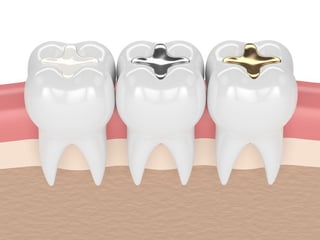 The bacteria in plaque produce acids that erode tooth enamel, eventually creating a hole, or cavity, in the tooth surface. Left untreated, this decay can spread to the interior of the tooth, and might lead to the need for a crown, a root canal, or even extraction. When caught early, your dentist can treat your cavity conservatively by restoring your tooth’s function and appearance with a filling.
The bacteria in plaque produce acids that erode tooth enamel, eventually creating a hole, or cavity, in the tooth surface. Left untreated, this decay can spread to the interior of the tooth, and might lead to the need for a crown, a root canal, or even extraction. When caught early, your dentist can treat your cavity conservatively by restoring your tooth’s function and appearance with a filling.
What kind of filling do you need? Your choice of restoration will depend on the location of the cavity and how much of the tooth structure is affected.
- Direct Filling
For most small to moderate cavities, direct fillings can be bonded to the tooth immediately after removing decay and cleaning and shaping the tooth.
Composite resin, dental amalgam, and glass ionomer fillings are typically used for this type of single visit restoration.
- Indirect Filling
An indirect filling is the right choice for molars and premolars with larger areas of decay or damage. Indirect fillings fit more securely, last longer than direct fillings, and can even strengthen the remaining tooth structure. An inlay fills the tooth surface inside the cusps, while an onlay typically covers the center of the tooth and one or more cusps.
Indirect fillings can be made of composite resin, gold, or porcelain, and are created from a mold taken after the tooth is cleaned and prepped. The finished filling is bonded to the tooth at a second visit.
Filling Options
Once you know what type of filing you need, you and your dentist can choose the best filling material for your tooth based on durability, aesthetics, longevity, and cost considerations:
- Composite Resin
Made of acrylic resin mixed with powdered quartz, glass, or other ceramic particles, composite resin can be used for both direct and indirect fillings.
Composite resin fillings are popular, especially for fillings in the front teeth, because they are color-matched to blend with natural enamel. These fillings generally preserve more of the tooth structure and are quite durable, although gold or porcelain might be a stronger choice for chewing surfaces. Composite resin fillings are more expensive than amalgams, and, unlike porcelain fillings, are more prone to staining.
- Dental Amalgam
An amalgam, or silver-colored, filling is composed of several different metals, including silver, tin, copper, and mercury.
Because this filling is very durable, it’s often the filling of choice for biting surfaces. It’s also one of the most cost-effective options. Amalgam fillings sometimes require the removal of more tooth structure than composite resin fillings, and won’t blend in with natural enamel. If you are concerned about the metals used in amalgams, discuss alternatives with your dentist.
- Glass Ionomer
Glass ionomer fillings use a flexible cement paste made with silicate glass powder. This filling material bonds to the tooth itself and hardens quickly. Resin-modified ionomers harden even more quickly under a curing light.
Many glass ionomer fillings contain fluoride that is released over time, helping to prevent new cavities. These fillings don’t blend as well with enamel as other tooth-colored options, and, because they are quite a bit less durable than other filling materials, they’re more suitable for baby teeth, cavities along the gum line or other non-biting surfaces, and temporary fillings.
- Gold
A gold filling is an alloy of gold, copper, and other metals. Gold is typically used in indirect fillings, and is extremely durable, lasting 20 years or more. Gold fillings are a more expensive option than composite resin, and, like silver amalgams, these fillings are visible.
- Porcelain
A porcelain filling is made from specially formulated ceramic materials and is used in indirect fillings.
Because porcelain fillings are both color-matched to the tooth and translucent, they are the most natural looking filling available. They are resistant to staining and cracking and are quite durable. Porcelain is a more expensive choice than composite resin, more comparable to the cost of a gold filling.
If you have a small or moderate cavity, there are a variety of filling choices available to address your functional, aesthetic, and cost concerns. Discuss these options with your dentist to discover which filling is best suited to restore and protect your healthy, attractive smile.
